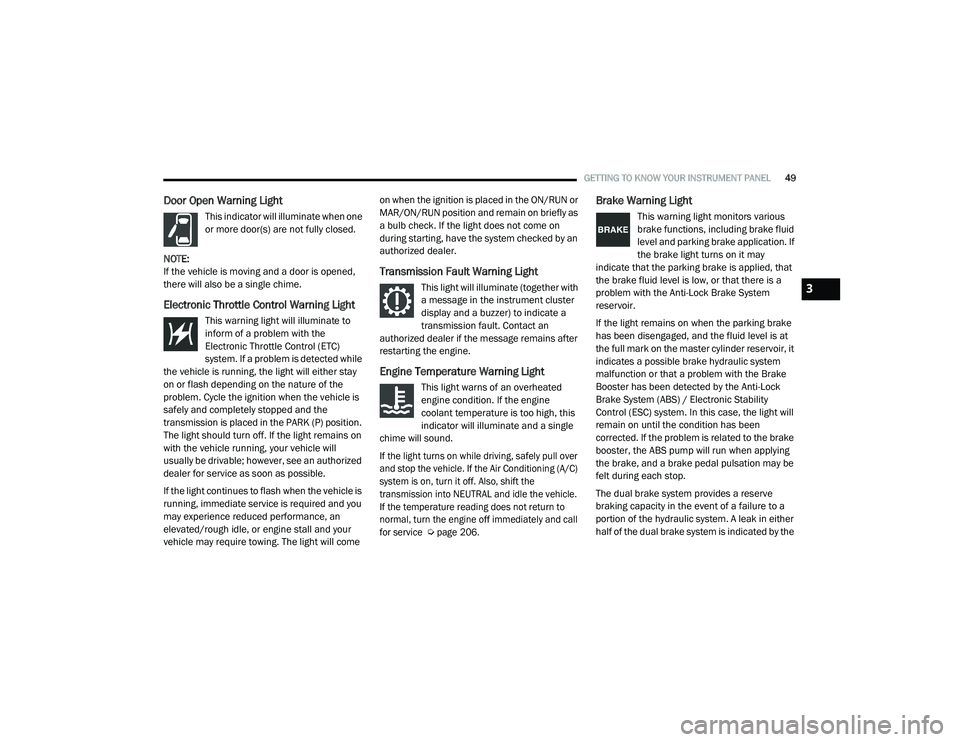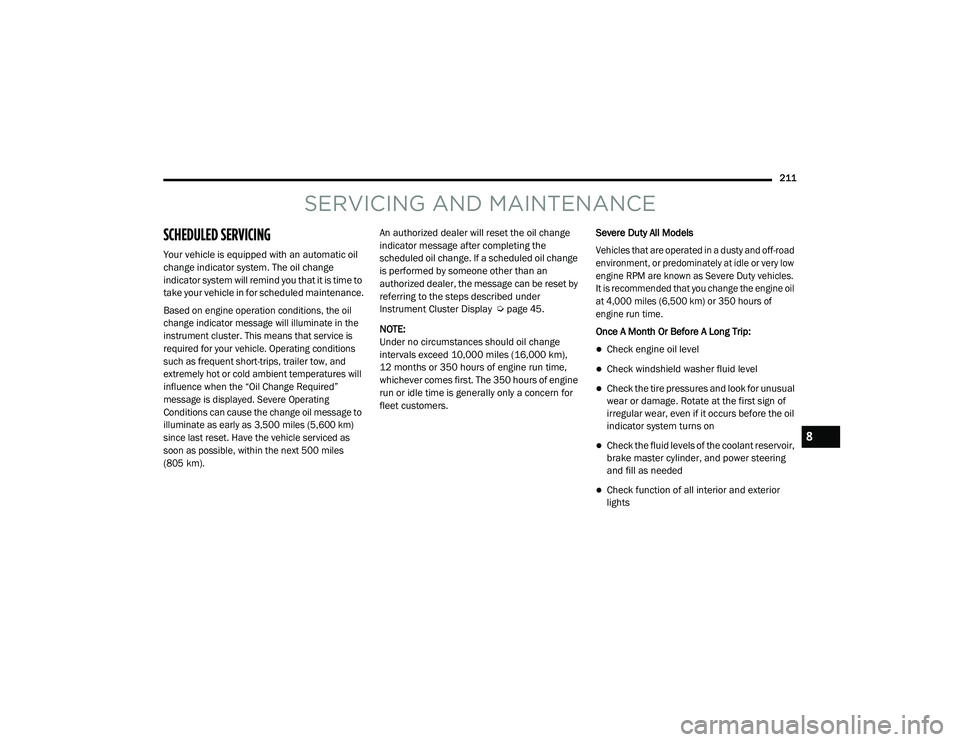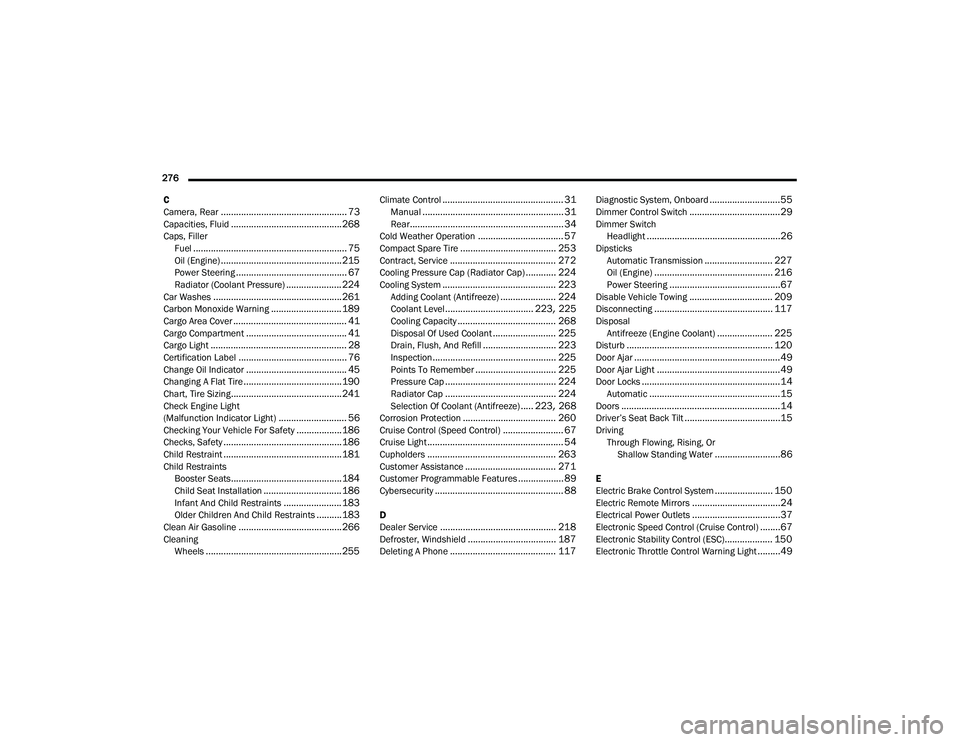coolant level RAM PROMASTER 2021 Owners Manual
[x] Cancel search | Manufacturer: RAM, Model Year: 2021, Model line: PROMASTER, Model: RAM PROMASTER 2021Pages: 288, PDF Size: 15.22 MB
Page 51 of 288

GETTING TO KNOW YOUR INSTRUMENT PANEL49
Door Open Warning Light
This indicator will illuminate when one
or more door(s) are not fully closed.
NOTE:
If the vehicle is moving and a door is opened,
there will also be a single chime.
Electronic Throttle Control Warning Light
This warning light will illuminate to
inform of a problem with the
Electronic Throttle Control (ETC)
system. If a problem is detected while
the vehicle is running, the light will either stay
on or flash depending on the nature of the
problem. Cycle the ignition when the vehicle is
safely and completely stopped and the
transmission is placed in the PARK (P) position.
The light should turn off. If the light remains on
with the vehicle running, your vehicle will
usually be drivable; however, see an authorized
dealer for service as soon as possible.
If the light continues to flash when the vehicle is
running, immediate service is required and you
may experience reduced performance, an
elevated/rough idle, or engine stall and your
vehicle may require towing. The light will come on when the ignition is placed in the ON/RUN or
MAR/ON/RUN position and remain on briefly as
a bulb check. If the light does not come on
during starting, have the system checked by an
authorized dealer.
Transmission Fault Warning Light
This light will illuminate (together with
a message in the instrument cluster
display and a buzzer) to indicate a
transmission fault. Contact an
authorized dealer if the message remains after
restarting the engine.
Engine Temperature Warning Light
This light warns of an overheated
engine condition. If the engine
coolant temperature is too high, this
indicator will illuminate and a single
chime will sound.
If the light turns on while driving, safely pull over
and stop the vehicle. If the Air Conditioning (A/C)
system is on, turn it off. Also, shift the
transmission into NEUTRAL and idle the vehicle.
If the temperature reading does not return to
normal, turn the engine off immediately and call
for service
Ú
page 206.
Brake Warning Light
This warning light monitors various
brake functions, including brake fluid
level and parking brake application. If
the brake light turns on it may
indicate that the parking brake is applied, that
the brake fluid level is low, or that there is a
problem with the Anti-Lock Brake System
reservoir.
If the light remains on when the parking brake
has been disengaged, and the fluid level is at
the full mark on the master cylinder reservoir, it
indicates a possible brake hydraulic system
malfunction or that a problem with the Brake
Booster has been detected by the Anti-Lock
Brake System (ABS) / Electronic Stability
Control (ESC) system. In this case, the light will
remain on until the condition has been
corrected. If the problem is related to the brake
booster, the ABS pump will run when applying
the brake, and a brake pedal pulsation may be
felt during each stop.
The dual brake system provides a reserve
braking capacity in the event of a failure to a
portion of the hydraulic system. A leak in either
half of the dual brake system is indicated by the
3
21_VF_OM_EN_USC_t.book Page 49
Page 213 of 288

211
SERVICING AND MAINTENANCE
SCHEDULED SERVICING
Your vehicle is equipped with an automatic oil
change indicator system. The oil change
indicator system will remind you that it is time to
take your vehicle in for scheduled maintenance.
Based on engine operation conditions, the oil
change indicator message will illuminate in the
instrument cluster. This means that service is
required for your vehicle. Operating conditions
such as frequent short-trips, trailer tow, and
extremely hot or cold ambient temperatures will
influence when the “Oil Change Required”
message is displayed. Severe Operating
Conditions can cause the change oil message to
illuminate as early as 3,500 miles (5,600 km)
since last reset. Have the vehicle serviced as
soon as possible, within the next 500 miles
(805 km).
An authorized dealer will reset the oil change
indicator message after completing the
scheduled oil change. If a scheduled oil change
is performed by someone other than an
authorized dealer, the message can be reset by
referring to the steps described under
Instrument Cluster Display Ú
page 45.
NOTE:
Under no circumstances should oil change
intervals exceed 10,000 miles (16,000 km),
12 months or 350 hours of engine run time,
whichever comes first. The 350 hours of engine
run or idle time is generally only a concern for
fleet customers. Severe Duty All Models
Vehicles that are operated in a dusty and off-road
environment, or predominately at idle or very low
engine RPM are known as Severe Duty vehicles.
It is recommended that you change the engine oil
at 4,000 miles (6,500 km) or 350 hours of
engine run time.
Once A Month Or Before A Long Trip:
Check engine oil level
Check windshield washer fluid level
Check the tire pressures and look for unusual
wear or damage. Rotate at the first sign of
irregular wear, even if it occurs before the oil
indicator system turns on
Check the fluid levels of the coolant reservoir,
brake master cylinder, and power steering
and fill as needed
Check function of all interior and exterior
lights
8
21_VF_OM_EN_USC_t.book Page 211
Page 226 of 288

224SERVICING AND MAINTENANCE
This vehicle has not been designed for use
with propylene glycol-based engine coolant.
Use of propylene glycol-based engine coolant
is not recommended.
Some vehicles require special tools to add
coolant properly. Failure to fill these systems
properly could lead to severe internal engine
damage. If any coolant is needed to be added
to the system please contact an authorized
dealer.
Adding Coolant
The vehicle has been built with an improved
engine coolant (OAT coolant conforming to
MS.90032) that allows extended maintenance
intervals. This engine coolant (antifreeze) can
be used up to 10 years or 150,000 miles
(240,000 km) before replacement. To prevent
reducing this extended maintenance period, it
is important that you use the same engine
coolant (OAT coolant conforming to MS.90032)
throughout the life of your vehicle. Please review these recommendations for
using OAT engine coolant that meets the
requirements of FCA Material Standard
MS.90032. When adding engine coolant:
We recommend using Mopar Antifreeze/
Coolant 10 Year/150,000 Mile (240,000 km)
Formula OAT that meets the requirements of
FCA Material Standard MS.90032.
Mix a minimum solution of 50% OAT engine
coolant that meets the requirements of FCA
Material Standard MS.90032 and distilled
water. Use higher concentrations (not to
exceed 70%) if temperatures below −34°F
(−37°C) are anticipated. Please contact an
authorized dealer for assistance.
Use only high purity water such as distilled or
deionized water when mixing the water/
engine coolant solution. The use of lower
quality water will reduce the amount of corro
-
sion protection in the engine cooling system.
NOTE:
It is the owner's responsibility to maintain the
proper level of protection against freezing
according to the temperatures occurring in
the area where the vehicle is operated.
Some vehicles require special tools to add
coolant properly. Failure to fill these systems
properly could lead to severe internal engine
damage. If any coolant is needed to be added
to the system, please contact a local autho -
rized dealer.
Mixing engine coolant types is not recom -
mended and can result in cooling system
damage. If HOAT and OAT coolant are mixed
in an emergency, have a authorized dealer
drain, flush, and refill with OAT coolant
(conforming to MS.90032) as soon as
possible.
Cooling System Pressure Cap
The cap must be fully tightened to prevent loss
of engine coolant (antifreeze), and to ensure
that engine coolant will return to the radiator
from the coolant recovery tank.
The cap should be inspected and cleaned if
there is any accumulation of foreign material on
the sealing surfaces.
21_VF_OM_EN_USC_t.book Page 224
Page 227 of 288

SERVICING AND MAINTENANCE225
Disposal Of Used Coolant
Used ethylene glycol-based coolant (antifreeze)
is a regulated substance requiring proper
disposal. Check with your local authorities to
determine the disposal rules for your
community. To prevent ingestion by animals or
children, do not store ethylene glycol-based
coolant in open containers or allow it to remain
in puddles on the ground. If ingested by a child
or pet, seek emergency assistance
immediately. Clean up any ground spills
immediately.
Coolant Level
The coolant expansion bottle provides a quick
visual method for determining that the coolant
level is adequate. With engine off and cold, the
level of the engine coolant (antifreeze) in the
bottle should be between the “MIN” and “MAX”
marks.
Cooling System Notes
NOTE:
When the vehicle is stopped after a few miles/
kilometers of operation, you may observe vapor
coming from the front of the engine compart -
ment. This is normally a result of moisture from
rain, snow, or high humidity accumulating on
the radiator and being vaporized when the ther -
mostat opens, allowing hot engine coolant (anti -
freeze) to enter the radiator.
If an examination of your engine compartment
shows no evidence of radiator or hose leaks,
the vehicle may be safely driven. The vapor will
soon dissipate.
Do not overfill the coolant expansion bottle.
Check the coolant freeze point in the radiator
and in the coolant expansion bottle. If engine
coolant needs to be added, the contents of the coolant expansion bottle must also be
protected against freezing.
If frequent engine coolant additions are
required, the cooling system should be pres
-
sure tested for leaks.
Maintain engine coolant concentration at a
minimum of 50% OAT coolant (conforming to
MS.90032) and distilled water for proper
corrosion protection of your engine which
contains aluminum components.
Make sure that the coolant expansion bottle
overflow hoses are not kinked or obstructed.
Keep the front of the radiator clean. If your
vehicle is equipped with air conditioning,
keep the front of the condenser clean.
Do not change the thermostat for Summer or
Winter operation. If replacement is ever
necessary, install ONLY the correct type ther -
mostat. Other designs may result in unsatis -
factory engine cooling performance, poor gas
mileage, and increased emissions.
WARNING!
Do not open hot engine cooling system.
Never add engine coolant (antifreeze) when
the engine is overheated. Do not loosen or
remove the cap to cool an overheated
engine. Heat causes pressure to build up in
the cooling system. To prevent scalding or
injury, do not remove the pressure cap
while the system is hot or under pressure.
Do not use a pressure cap other than the
one specified for your vehicle. Personal
injury or engine damage may result.
8
21_VF_OM_EN_USC_t.book Page 225
Page 277 of 288

275
INDEX
A
Adding Engine Coolant (Antifreeze)............... 224Adding Washing Fluid.................................... 217Additives, Fuel............................................... 266Advance Phone Connectivity......................... 121Air Bag........................................................... 174Air Bag Operation...................................... 175Air Bag Warning Light................................ 173Enhanced Accident Response...................210Event Data Recorder (EDR)....................... 210If Deployment Occurs................................ 178Maintaining Your Air Bag System.............. 179Maintenance............................................. 179Side Air Bags............................................. 175Transporting Pets...................................... 187Air Bag Light..................................48, 173, 187Air Cleaner, Engine
(Engine Air Cleaner Filter).............................. 219Air Conditioner Maintenance......................... 219Air Conditioner Refrigerant.................. 219, 220Air Conditioner System.................................. 219Air Conditioning Filter............................. 35, 220Air Conditioning, Operating Tips................ 34, 35Air Filter......................................................... 219Air PressureTires.......................................................... 249
AlarmSecurity Alarm...................................... 13, 50Alarm SystemSecurity Alarm............................................. 13Alterations/ModificationsVehicle........................................................... 7Antifreeze (Engine Coolant)................. 223, 268Disposal................................................... 225Anti-Lock Brake System (ABS)...................... 149Anti-Lock Warning Light................................... 53Assist, Hill Start............................................. 153Audio Settings............................................... 107Audio Systems (Radio)..................................... 88Auto Down Power Windows............................. 39Auto Up Power Windows.................................. 39Automatic Door Locks...................................... 15Automatic Transmission.........................60, 227Adding Fluid.............................................. 227Fluid And Filter Change............................ 227Fluid Change............................................ 227Fluid Level Check............................ 226, 227Fluid Type........................................ 226, 270Special Additives...................................... 227AUX Cord.......................................................... 37Auxiliary Driving Systems.............................. 155
B
Battery................................................... 48, 217Charging System Light.................................48Keyless Key Fob Replacement....................11Belts, Seat.................................................... 187Blind Spot Monitoring................................... 155BluetoothConnecting To A Particular Mobile PhoneOr Audio Device After Pairing
................ 116Body Builders Guide........................................... 7Body Mechanism Lubrication........................ 221B-Pillar Location............................................ 245Brake Assist System..................................... 150Brake Control System, Electronic.................. 150Brake Fluid........................................... 226, 270Brake System....................................... 226, 264Anti-Lock (ABS)......................................... 149Fluid Check............................................... 226Master Cylinder........................................ 226Parking........................................................59Warning Light...............................................49Brake, Parking.................................................59Brake/Transmission Interlock..........................60Bulb Replacement........................................ 235Bulbs, Light.......................................... 188, 23511
21_VF_OM_EN_USC_t.book Page 275
Page 278 of 288

276 C
Camera, Rear
.................................................. 73Capacities, Fluid............................................ 268Caps, Filler Fuel............................................................. 75Oil (Engine)................................................ 215Power Steering............................................ 67Radiator (Coolant Pressure)...................... 224Car Washes................................................... 261Carbon Monoxide Warning............................ 189Cargo Area Cover............................................. 41Cargo Compartment........................................ 41Cargo Light...................................................... 28Certification Label........................................... 76Change Oil Indicator........................................ 45Changing A Flat Tire....................................... 190Chart, Tire Sizing............................................ 241Check Engine Light
(Malfunction Indicator Light)........................... 56Checking Your Vehicle For Safety.................. 186Checks, Safety............................................... 186Child Restraint............................................... 181Child RestraintsBooster Seats............................................ 184Child Seat Installation............................... 186Infant And Child Restraints....................... 183Older Children And Child Restraints..........183Clean Air Gasoline......................................... 266CleaningWheels...................................................... 255
Climate Control................................................ 31Manual........................................................ 31Rear............................................................. 34Cold Weather Operation.................................. 57Compact Spare Tire...................................... 253Contract, Service.......................................... 272Cooling Pressure Cap (Radiator Cap)............ 224Cooling System............................................. 223Adding Coolant (Antifreeze)...................... 224Coolant Level................................... 223, 225Cooling Capacity....................................... 268Disposal Of Used Coolant......................... 225Drain, Flush, And Refill............................. 223Inspection................................................. 225Points To Remember................................ 225Pressure Cap............................................ 224Radiator Cap............................................ 224Selection Of Coolant (Antifreeze)..... 223, 268Corrosion Protection..................................... 260Cruise Control (Speed Control)........................ 67Cruise Light...................................................... 54Cupholders................................................... 263Customer Assistance.................................... 271Customer Programmable Features.................. 89Cybersecurity................................................... 88
D
Dealer Service.............................................. 218Defroster, Windshield................................... 187Deleting A Phone.......................................... 117
Diagnostic System, Onboard............................55Dimmer Control Switch....................................29Dimmer SwitchHeadlight.....................................................26DipsticksAutomatic Transmission........................... 227Oil (Engine)............................................... 216Power Steering............................................67Disable Vehicle Towing................................. 209Disconnecting............................................... 117DisposalAntifreeze (Engine Coolant)...................... 225Disturb.......................................................... 120Door Ajar..........................................................49Door Ajar Light.................................................49Door Locks.......................................................14Automatic....................................................15Doors...............................................................14Driver’s Seat Back Tilt......................................15DrivingThrough Flowing, Rising, Or Shallow Standing Water
..........................86
E
Electric Brake Control System....................... 150Electric Remote Mirrors...................................24Electrical Power Outlets...................................37Electronic Speed Control (Cruise Control)........67Electronic Stability Control (ESC)................... 150Electronic Throttle Control Warning Light.........49
21_VF_OM_EN_USC_t.book Page 276
Page 279 of 288

277
Emergency, In Case Of Freeing Vehicle When Stuck
...................... 208Jacking...................................................... 190Jump Starting............................................ 203Emission Control System Maintenance........... 56Engine........................................................... 215Air Cleaner................................................. 219Block Heater............................................... 58Break-In Recommendations........................ 58Checking Oil Level..................................... 216Compartment............................................ 215Compartment Identification...................... 215Coolant (Antifreeze)......................... 223, 268Cooling...................................................... 223Exhaust Gas Caution................................. 189Fails To Start............................................... 57Flooded, Starting......................................... 57Fuel Requirements.......................... 265, 268Jump Starting............................................ 203Oil.................................................... 218, 268Oil Filler Cap.............................................. 215Oil Filter..................................................... 219Oil Selection.................................... 218, 268Oil Synthetic.............................................. 218Overheating............................................... 206Starting....................................................... 57Enhanced Accident Response Feature..........210Entry System, Illuminated................................ 30
Ethanol......................................................... 266Exhaust Gas Cautions................................... 189Exhaust System................................... 189, 221Exterior Lights.........................................26, 188
F
FiltersAir Cleaner
................................................ 219Air Conditioning..................................35, 220Engine Oil........................................ 219, 268Engine Oil Disposal................................... 218FlashersHazard Warning........................................ 190Turn Signals.......................................54, 188Flat Tire Changing................................ 240, 253Flat Tire Stowage................................. 240, 253Flooded Engine Starting................................... 57Fluid Capacities............................................ 268Fluid Leaks................................................... 189Fluid Level ChecksAutomatic Transmission........................... 227Brake........................................................ 226Cooling System......................................... 223Engine Oil................................................. 216Power Steering............................................ 67Fog Lights........................................................ 27Fold-Flat Seats................................................. 15Forward Collision Warning............................ 159
Four-Way Hazard Flasher.............................. 190Freeing A Stuck Vehicle................................. 208Fuel............................................................... 265Additives................................................... 266Clean Air................................................... 266Ethanol..................................................... 266Filler Cap (Gas Cap).....................................75Gasoline................................................... 265Materials Added....................................... 266Methanol.................................................. 266Octane Rating.................................. 265, 268Requirements.................................. 265, 268Tank Capacity........................................... 268Fuses............................................................ 228
G
Gas Cap (Fuel Filler Cap)...........................75, 76Gasoline, Clean Air........................................ 266Gasoline, Reformulated................................ 266Gear Ranges....................................................62Gear Selector Override.................................. 207Glass Cleaning.............................................. 263Gross Axle Weight Rating.......................... 76, 78Gross Vehicle Weight Rating.....................76, 78GuideBody Builders................................................. 7GVWR...............................................................7611
21_VF_OM_EN_USC_t.book Page 277